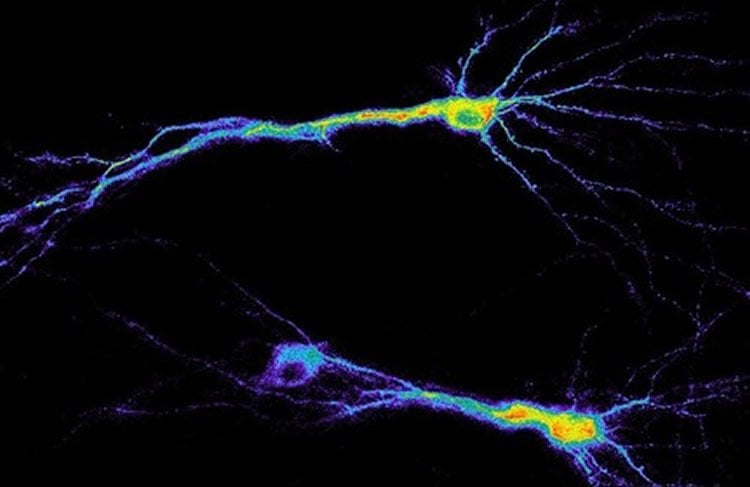Summary: Researchers report Rolofylline could help alleviate learning and memory problems associated with aggregating Tau proteins.
Source: DZNE.
Drug “Rolofylline” a possible antidote.
In a study published in the journal PNAS scientists of the German Center for Neurodegenerative Diseases (DZNE) present new findings on the role of the protein Tau in certain brain diseases. Their report which is based on laboratory studies suggests that the drug “Rolofylline” could possibly alleviate learning and memory problems associated with aggregating Tau proteins.
The brain could easily be compared to the internet. In both networks information is transmitted from one unit to the next with numerous units making up the network. Unlike computers, neurons are interconnected by axons, thin biological wires which can be as long as one meter. A protein called Tau normally helps in maintaining axonal integrity by stabilizing the tracks which are necessary to transport cellular components within the axon. However, Tau goes astray in multiple neurodegenerative diseases like Alzheimer’s and other “tauopathies”. Here it starts to aggregate into tiny fibers or clumps, which can corrupt neuronal function. However, the underlying mechanisms are poorly understood and there is therefore no effective treatment.
Now, researchers at the DZNE and the caesar research center led by Eva-Maria and Eckhard Mandelkow shed new light on the pathological processes that involve Tau proteins. As they report in the “Proceedings of the National Academy of Sciences of the USA” (PNAS), under pathological conditions, small aggregates of Tau accumulate in the axons. As a result, neuronal activity is attenuated but neurons do not die and do not seem to be seriously ill. The aggregates only let neurons, so to say, doze off. However, the researchers also found a potential antidote: A drug called “Rolofylline”. It re-establishes neuronal activity despite of the production of pathological Tau. Rolofylline works by enhancing signal transmission and reception which strengthens the communication between nerve cells. Consequently, Rolofylline alleviates learning and memory deficits in mice that express the aberrant Tau protein, as the scientists have revealed.

Rolofylline was originally devised to treat renal dysfunction in human heart failure patients. The drug binds to a subset of cellular sensors called “adenosine A1 receptors”. Thereby, signal pathways are blocked, that otherwise would down-regulate neuronal network activity. Patients with neurodegenerative diseases might benefit from this. “Our results suggest that Rolofylline could potentially be useful to treat neuronal dysfunctions that occur in tauopathies. This makes the drug a hot candidate for further studies. As an analogy, the Tau aggregates resemble a concrete wall in the middle of the room which blocks a WiFi signal. Rolofylline seems to work as a WiFi booster that can re-establish the connection despite of the obstruction”, says Frank Dennissen, a member of the Mandelkow Lab and first author of the current paper.
Source: Marcus Neitzert – DZNE
Image Source: NeuroscienceNews.com image is credited to DZNE/Frank Dennissen.
Original Research: Abstract for “Adenosine A1 receptor antagonist rolofylline alleviates axonopathy caused by human Tau ΔK280” by Frank J. A. Dennissen, Marta Anglada-Huguet, Astrid Sydow, Eckhard Mandelkow and Eva-Maria Mandelkow in PNAS. Published online September 26 2016 doi:10.1073/pnas.1603119113
[cbtabs][cbtab title=”MLA”]DZNE. “Aberrant Tau Proteins Put Neuronal Networks to Sleep.” NeuroscienceNews. NeuroscienceNews, 9 October 2016.
<https://neurosciencenews.com/tau-neural-networks-5246/>.[/cbtab][cbtab title=”APA”]DZNE. (2016, October 9). Aberrant Tau Proteins Put Neuronal Networks to Sleep. NeuroscienceNews. Retrieved October 9, 2016 from https://neurosciencenews.com/tau-neural-networks-5246/[/cbtab][cbtab title=”Chicago”]DZNE. “Aberrant Tau Proteins Put Neuronal Networks to Sleep.” https://neurosciencenews.com/tau-neural-networks-5246/ (accessed October 9, 2016).[/cbtab][/cbtabs]
Abstract
Adenosine A1 receptor antagonist rolofylline alleviates axonopathy caused by human Tau ΔK280
Accumulation of Tau is a characteristic hallmark of several neurodegenerative diseases but the mode of toxic action of Tau is poorly understood. Here, we show that the Tau protein is toxic due to its aggregation propensity, whereas phosphorylation and/or missorting is not sufficient to cause neuronal dysfunction. Aggregate-prone Tau accumulates, when expressed in vitro at near-endogenous levels, in axons as spindle-shaped grains. These axonal grains contain Tau that is folded in a pathological (MC-1) conformation. Proaggregant Tau induces a reduction of neuronal ATP, concomitant with loss of dendritic spines. Counterintuitively, axonal grains of Tau are not targeted for degradation and do not induce a molecular stress response. Proaggregant Tau causes neuronal and astrocytic hypoactivity and presynaptic dysfunction instead. Here, we show that the adenosine A1 receptor antagonist rolofylline (KW-3902) is alleviating the presynaptic dysfunction and restores neuronal activity as well as dendritic spine levels in vitro. Oral administration of rolofylline for 2-wk to 14-mo-old proaggregant Tau transgenic mice restores the spatial memory deficits and normalizes the basic synaptic transmission. These findings make rolofylline an interesting candidate to combat the hypometabolism and neuronal dysfunction associated with Tau-induced neurodegenerative diseases.
“Adenosine A1 receptor antagonist rolofylline alleviates axonopathy caused by human Tau ΔK280” by Frank J. A. Dennissen, Marta Anglada-Huguet, Astrid Sydow, Eckhard Mandelkow and Eva-Maria Mandelkow in PNAS. Published online September 26 2016 doi:10.1073/pnas.1603119113






